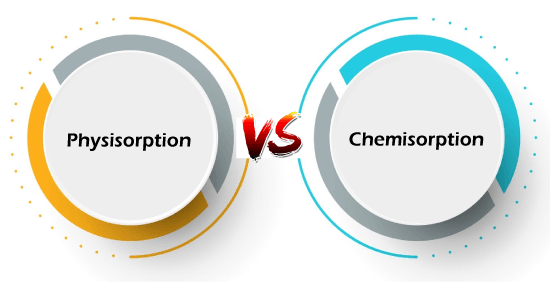Difference between Physisorption and ChemisorptionChemistry is a broad subject comprising of different topics like atoms, molecules, chemical reactions, acids, bases, etc. All these subjects are used to study and understand the basis of chemicals. There are a variety of chemicals that are used in our day-to-day lives. So, today we will be discussing about the two kinds of adsorption. But let us first understand the meaning of adsorption. Adsorption is defined as the process wherein the solid hold the molecules of liquid and gas as a thin film. Adsorption is basically the sticking/ fixing of the atoms, molecules, or ions from a liquid or gaseous surface. In chemistry, it is a mass transfer process. The unsaturated forces are adsorped at solid surfaces. Now, there are two kinds of adsorption, i.e., physisorption and chemisorption. Let us discuss them in detail. 
PhysisorptionPhysisorption is defined as the process wherein the structure of a molecule/ atom is unsettled. Physisorption is also known as physical adsorption, i.e., the physical bonding of gas molecules with the liquid or solid surface. The gas molecules and the surfaces come under contact at low temperatures. Interestingly, physisorption is caused by the intermolecular force between adsorbents and adsorbates. Physisorption majorly occurs on the solid surface. This kind of adsorption is called 'Van Der Waals', and the force it exhibits is called 'Van Der Waals Force.' Physisorption is an exothermic process. The sum of the volume, product pressure, and internal energy is relatively low because the van der Waals force is weakened in the physisorption process. Physisorption can be reversed if the pressure is relatively decreased. Physisorption creates many multi-molecular layers, and this process does not require any activation energy. The interaction energy is weak in physisorption, but it plays an important role. The process of physisorption is used to examine the interaction between molecules and the solid surface. One of the common examples of physisorption is the adsorption of gases such as nitrogen, hydrogen, etc. These gases interact at a low temperature. With the increase in adsorption, the surface area also increases. Thus, adsorption depends upon the nature of adsorbate. ChemisorptionChemisorption is defined as a process in which the chemical reaction between the adsorbate and adsorbent takes place. The process comprises of transfer and sharing electrons between adsorbents and adsorbates. Chemisorption is an exothermic process that occurs when there is an increase in temperature. This process begins at a low temperature, followed by an increase in pressure. A chemical bond is formed in this process, and the sum of internal energy, volume, product pressure is relatively high. Examples of chemisorption include macroscopic phenomena like corrosion. Chemisorption is also seen in heterogeneous catalysts wherein the molecules react with one another through chemisorbed intermediates. Chemisorption is specific in nature. In this process, the adsorbents and adsorbates get linked to one another through chemical bonds. These bonds are either ionic or covalent in nature. The activation energy in this process is also high, along with high temperatures. It is interesting to note that the chemisorption process is reversible. However, it is not much affected by the slight changes in pressure. Thus, chemisorption takes place in case of high temperatures. Now, there are several differences between physisorption and chemisorption. So, let us have a look at them.
So, these are some of the contrasting points between physisorption and chemisorption. Both these processes are essential for the formation of chemical bonds and intermolecular connections. Thus, both physisorption and chemisorption are a significant part of chemistry.
Next TopicDifference between
|
 For Videos Join Our Youtube Channel: Join Now
For Videos Join Our Youtube Channel: Join Now
Feedback
- Send your Feedback to [email protected]
Help Others, Please Share










